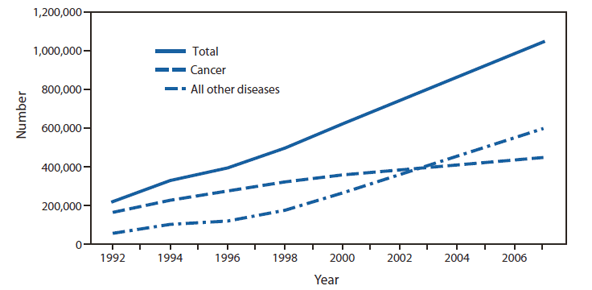Persons using assistive technology might not be able to fully access information in this file. For assistance, please send e-mail to: mmwrq@cdc.gov. Type 508 Accommodation and the title of the report in the subject line of e-mail.
QuickStats: Annual Number of Patients Discharged from Hospice Care, by Primary Diagnosis (Cancer Versus All Other Diseases)* --- United States, National Home and Hospice Care Survey, 1992--2007

* Primary diagnosis is assessed on admission for hospice-care services. Estimates are based on the number of discharged patients, the majority of whom leave hospice care at death. Some patients might discontinue care while living, some might reenter care, and some might have more than one episode of care in a 12-month period.
Use of hospice care increased from approximately 219,300 discharged hospice-care patients in 1992 to 1,045,100 in 2007. In 1992, three out of four patients (approximately 163,600) had a primary diagnosis of cancer, compared with 55,500 patients with all other diseases. In 2007, less than half of patients (42%) had a primary diagnosis of cancer, for a total of 447,600 cancer patients, compared with 597,500 patients with all other diseases.
Source: CDC. National Home and Hospice Care Survey data, 1992, 1994, 1996, 1998, 2000, 2002, 2004, and 2007. Additional information available at http://www.cdc.gov/nchs/nhhcs.htm.
Alternate Text: The figure above shows the annual number of patients discharged from hospice care, by primary diagnosis (cancer versus all other diseases) in the United States during 1992-2007. Use of hospice care increased from approximately 219,300 discharged hospice-care patients in 1992 to 1,045,100 in 2007. In 1992, three out of four patients (approximately 163,600) had a primary diagnosis of cancer, compared with 55,500 patients with all other diseases. In 2007, less than half of patients (42%) had a primary diagnosis of cancer, for a total of 447,600 cancer patients, compared with 597,500 patients with all other diseases.
Use of trade names and commercial sources is for identification only and does not imply endorsement by the U.S. Department of
Health and Human Services.
References to non-CDC sites on the Internet are
provided as a service to MMWR readers and do not constitute or imply
endorsement of these organizations or their programs by CDC or the U.S.
Department of Health and Human Services. CDC is not responsible for the content
of pages found at these sites. URL addresses listed in MMWR were current as of
the date of publication.
All MMWR HTML versions of articles are electronic conversions from typeset documents.
This conversion might result in character translation or format errors in the HTML version.
Users are referred to the electronic PDF version (http://www.cdc.gov/mmwr)
and/or the original MMWR paper copy for printable versions of official text, figures, and tables.
An original paper copy of this issue can be obtained from the Superintendent of Documents, U.S.
Government Printing Office (GPO), Washington, DC 20402-9371;
telephone: (202) 512-1800. Contact GPO for current prices.
**Questions or messages regarding errors in formatting should be addressed to
mmwrq@cdc.gov.
 ShareCompartir
ShareCompartir


